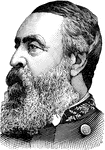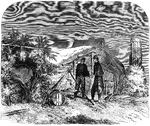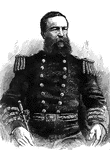
Admiral David Dixon Porter
"Admiral Porter, born in Chester, Delaware County, Pa., June 8th, 1813; died in Washington, D. C., February…

General Fitzjohn Porter
"General Porter, born at Portsmouth, N. H., June 13th, 1822, was graduated from the United States Military…

Army of the Potomac
"Advance of the Army of the Potomac. Occupation of Winchester, VA., and the abandoned Confederate Fortifications,…

Army of the Potomac
"Army of the Potomac recrossing the Rappahannock from Fredericksburg to Falmouth, on the night of Monday,…

Battle at Potomac
"Engagement between the Federal troops and the Confederates on the Virginia side of the Potomac, opposite…
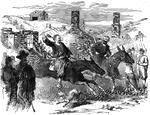
Passage of the Potomac
"A street in Harper's Ferry, VA., during the passage of the Potomac by the Federal troops from Maryland,…

Recrossing the Potomac
"General Banks's Division recrossing the Potomac from Williamsport, Md., to attack the Confederate army…
!["Presentation of colors to the Twentieth United States [African American] Infantry, Colonel Bartram, at the Union League Clubhouse, New York, March 5th, 1864. The Twentieth Regiment, United States [African American] Troops, left Riker's Island at nine o'clock on the 5th of March, 1864, on board the steamer <em>John Romer</em>, and were conveyed to the foot of Twenty-first Street, East River, New York, where they were disembarked and formed in regimental line, and marched to Union Square, arriving in front of the Union League Clubhouse at one o'clock. A vast crowd of citizens, of every shade of color and every phase of social and political life, filled the square and streets, and every door, window, veranda, tree and housetop that commanded a view of the scene was peopled with spectators. Over the entrance of the clubhouse was a large platform, ornamented with flags and filled with ladies. In the street was another platform, tastefully decorated and occupied by prominent citizens. From the stand the colors were presented by President King of Columbia College, who addressed them with warmth and eloquence. After the presentation ceremony was over the men stacked arms and partook of a collation provided for them."— Frank Leslie, 1896](https://etc.usf.edu/clipart/11700/11749/presentcolor_11749_mth.gif)
Presentation of Colors
"Presentation of colors to the Twentieth United States [African American] Infantry, Colonel Bartram,…

President Lincoln
"President Lincoln riding through Richmond, Va., April 4th, 1865, and the enthusiastic cheers of the…

Camp Princeton
"New Jersey Camp at Arling, Va., designated as Camp Princeton in honor of one of the Revolutionary battle…

Prison
"The humors of a prison- scene in a station-house cell, Washington, D. C., after the appointment of…

Prison Pen
"The great Prison Pen at Andersonville, Ga. The stockade was orginally eleven acres, which was increased…
Prison Reception
"Reception of Confederate prisoners at the Federal prison, Elmira, N. Y. The prison at Elmira, N. Y.,…

Gratiot Street Prison
The Gratiot Street Prison was an American Civil War prison located in St. Louis, Missouri and was the…

Pulaski Monument
"Review of Confederate troops on their march to Virginia, in front of the Pulaski Monument, Monument…

Fort Pulaski
Fort Pulaski, on Cockspur Island at the entrance to the Savannah River, Georgia, was built by the United…

Fort Pulaski
"The bombardment of Fort Pulaski, second day, Friday, April 11th, 1862. General Quincy A. Gilmore took…

Quaker City
"The Quaker City, one of the Potomac Flotilla, engaging Confederate dragoons in Lynn Haven…
Rappahannock
"The city of Fredericksburg, VA., from the North side of the Rappahannock- from a sketch by our special…

Rappahannock Bridge
"Rebuilding of the railroad bridge over the Rappahannock to Fredericksburg, burnt by the Confederates…

Rappahannock River
American soldiers retreating across the Rappahannock river in Northwest Virginia. It shows an example…
Recrossing the Rappahannock
"The war in Virginia. General Meade recrossing the Rappahannock, October, 1863, before Lee's advance.…

Re-enforcements
"Re-enforcements for Grant's army leaving Memphis, Tenn. Our sketch shows the Alice Dean, a…

Battle of Ream's Station
"The Siege of Petersburg. Battle of Ream's Station- the attempt of the enemy to regain the Weldon Railroad…

Reconnoissance
"Reconnoissance by Colonel Max Weber's Turner rifles in the vicinity of Newmarket Bridge, on the road…

Red River
"The war on the Red River. Admiral Porter's fleet passing through Colonel Bailey's Dam, above Alexandria,…
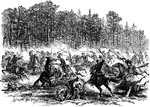
Sixth Regiment
"Gallant charge of the Sixth Regiment, United States Regular Cavalry, upon the Confederate Stuart's…
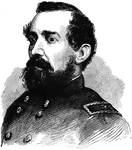
General Jesse L. Reno
"General Reno, born in Wheeling, W. Va., June 20th, 1823, died on South Mountain, Md., September 14th,…

Battle of Resaca
"Battle of Resaca, Ga., May 14th, 1864. Geary's Second Brigade charging up the mountain."— Frank…

Lincoln Review
In 1863, president Lincoln reviewed some sixty thousand troops in the small town of Falmouth VA. Although…

Rhode Island Regiments
"Rhode Island Regiments embarking at Providence for New York and Washington. Within five days after…
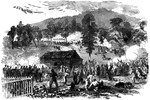
Battle of Rich Mountain
"The battle of Rich Mountain, Beverly Pike, Va., between a division of Major General McClellan's command,…

Richmond
"The Federal army entering Richmond, Va., April 3rd, 1865- reception of the troops in Main Street."—…

Rifle Pits
"Siege of Vicksburg- sharpshooters in the rifle pits constructed by Captain Hickenlooper."— Frank…
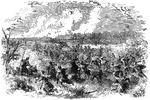
Battle of Roanoke Island
"Battle of Roanoke Island, February 8th, 1862- decisive bayonet charge of the Ninth New York Volunteers…
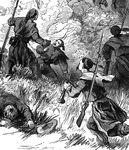
Battle of Roanoke Island
"Battle of Roanoke Island, February 8th, 1862- decisive bayonet charge of the Ninth New York Volunteers…

Battle of Roanoke Island
"Battle of Roanoke Island, February 8th, 1862- decisive bayonet charge of the Ninth New York Volunteers…
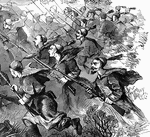
Battle of Roanoke Island
"Battle of Roanoke Island, February 8th, 1862- decisive bayonet charge of the Ninth New York Volunteers…

Robinson's House in Battle of Bull Run
The Robinson House belonged to a free African American during the First Battle of Bull Run. The house…

Roemer's Battery
"The war in Virginia- Roemer's Battery, Third Division, Ninth Army Corps, shelling Petersburg. Our readers…

Rolla Camp
"Encampment of the Federal army near Rolla, Mo. The city of Rolla has been famous since the death of…

Engagement at Romney
"Engagement at Romney, VA., twenty miles from New Creek, Tuesday, June 11th, 1861- the Eleventh Indiana…

General Rosecrans
"General Rosecrans, commanding the Department of Western Virginia, surrounded by his staff, at their…

Roswell's Ferry
"The war in Georgia- the Sixteenth Army Corps fording the Chattahoochee at Roswell's Ferry, July 10th,…

Ascent of Round Top
"Visit of Union and Confederate officers to Gettysburg, the ascent of Round Top."— Frank Leslie,…

Theodore Runyon
"New Jersey Camp at Arling, Va., designated as Camp Princeton in honor of one of the Revolutionary battle…

General Jeremiah M. Rusk
"General Rusk, born in Morgan County, Ohio, June 17th, 1830; died in 1894. He divided his time between…
